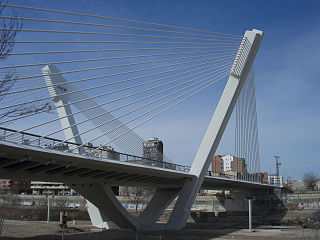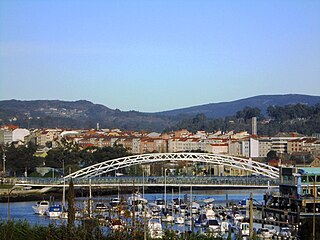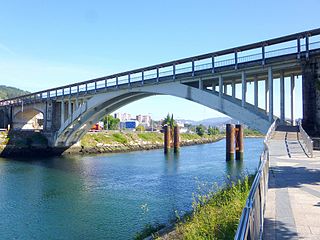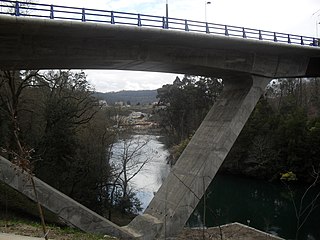
Pontevedra is a Spanish city in the north-west of the Iberian Peninsula. It is the capital of both the Comarca (County) and Province of Pontevedra, and of the Rías Baixas in Galicia. It is also the capital of its own municipality which is often considered an extension of the actual city.

Javier Manterola Armisén is a Spanish civil engineer and professor at the Escuela Superior de Ingenieros de Madrid. Manterola is particularly known for his work as a bridge designer of the engineering firm Carlos Fernández Casado. Author of numerous and varied projects, in collaboration with different Spanish architects as Rafael Moneo, has won over his professional career several awards such as the Premio Príncipe de Viana de la Cultura. He is a member of the Real Academia de Bellas Artes de San Fernando.

The Burgo Bridge(Puente del Burgo) is a medieval bridge, built over an older bridge of Roman origin, which crosses the Lérez River in the city of Pontevedra, Spain. It is on the route of the Portuguese Way to the north of the historic centre of Pontevedra and to the south of the Burgo neighbourhood. Between the arches above the pillars are carved the famous stone pilgrim's shells.

The Currents Bridge, is a tied-arch bridge that crosses the Lérez River in the city of Pontevedra, Spain. It was inaugurated in 2012 and connects Uruguay Avenue and Domingo Fontán Street.

The Tirantes Bridge is a cantilever spar cable-stayed bridge that crosses the Lérez River in the city of Pontevedra, Spain, linking the south bank to the north bank at the level of the city's Congress Hall.

The Pontevedra Auditorium and Convention Centre is a building that hosts conventions, exhibitions, concerts, plays and ballet and dance performances in Pontevedra (Spain). It is located in the northern part of the city, next to the Lérez river and the Tirantes bridge and was designed by the architect Manuel de las Casas.

The Lérez beach is a Galician beach located in the municipality of Pontevedra in the province of Pontevedra, Spain. It is a semi-urban river beach with a length of 100 metres.

The marina of Pontevedra is located at the mouth of the Lérez river in the ria de Pontevedra. Its nautical chart is 4162-HMI. It is managed by the Nautical Club of Pontevedra, by concession of the public entity of the Ports of Galicia – South Zone.

The Natural Park of the Marismas de Alba, the Alba Marsh or the Xunqueira de Alba, is a natural park and wetland in the city of Pontevedra in Spain, and one of the few Marshes in the Ria de Pontevedra. It is a park used as a place for walking, cycling and observing the fauna and flora.

The port of Marín and Ria de Pontevedra is located in the municipalities of Marín and Pontevedra, Galicia (Spain). It is on the southern shore of the Ria de Pontevedra.

The Barca Bridge is a bridge over the Lérez River, at its mouth in the Pontevedra Ria, which connects the city of Pontevedra with the municipality of Poio in Spain.

Dorna is a sculpture created by the Spanish artist Xaime Quesada, located in Pontevedra (Spain). It is also known as Tribute to the pilgrimage way to Santiago de Compostela and is currently in Gorgullón Street on the Portuguese Way opposite the Vialia shopping centre.

The paseo marítimo of Pontevedra is a pedestrian way along the seafront facing the ria of Pontevedra, in Pontevedra, Spain. This coastal public space is built in the urban and semi-urban area of the city and defines its encounter with the sea and the Lérez river.

O Burgo is a neighbourhood in the city of Pontevedra (Spain). It is one of the oldest neighbourhoods in the city and is crossed by the Portuguese Way. On its right-hand side is the A Xunqueira area with important educational and cultural facilities.

The Santiago Bridge crosses the Lérez River in the city of Pontevedra (Spain), where the N-550 road runs alongside it. It connects the city centre with the A Xunqueira area and the O Burgo district.

Mollavao is a neighbourhood in the city of Pontevedra (Spain), in its southwestern area, next to the Ria de Pontevedra. It has mainly a residential function.

The Word Bridge is a delta-leg bridge that crosses the Lérez River in the Monte Porreiro district of the city of Pontevedra (Spain). It was inaugurated in 2011 and connects the Monte Porreiro neighbourhood with the civil parish of Lérez.
Leonardo Fernández Troyano is a Spanish engineer, architect and author. He is the co-chair of CFCSL.


























